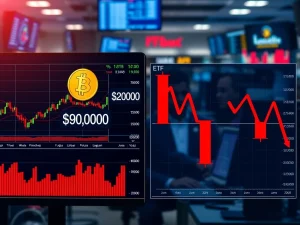Bitcoin Whale Unleashes Massive Market Shock: Dormant Bitcoin Transfer Triggers Price Impact Fears

A colossal movement has just shaken the crypto world, leaving investors and analysts buzzing. A long-dormant Bitcoin wallet, holding a significant amount of BTC, has suddenly come to life. This massive Bitcoin whale transfer is more than just a transaction; it’s a seismic event that has ignited widespread crypto market speculation about its potential ramifications for the entire ecosystem.
What Exactly Happened with This Historic Bitcoin Whale Transfer?
On July 24, 2025, the crypto community witnessed a staggering event: approximately 3,962.62 BTC, valued at nearly $470 million, moved from a wallet that had been inactive for years. This isn’t just any transfer; it’s one of the largest reactivations of previously inactive Bitcoin holdings in recent memory. Tracked by vigilant on-chain analytics firms like Onchain Lens, this movement immediately triggered intense scrutiny.
- The Scale: Nearly 4,000 BTC, worth almost half a billion dollars.
- The Origin: A wallet dormant for several years, signifying a ‘whale’ who held onto their assets through multiple market cycles.
- The Impact: Immediate widespread speculation among investors and analysts regarding market liquidity and future price dynamics.
While the precise intent behind this particular Bitcoin whale transfer remains undisclosed, the event underscores the pivotal role of large-scale on-chain activity in shaping the cryptocurrency ecosystem.
Why is Dormant Bitcoin Movement Sparking Crypto Market Speculation?
The sudden activation of such a large amount of dormant Bitcoin is rarely a random occurrence. When a wallet that has been inactive for an extended period suddenly moves funds, it often signals a strategic shift by the holder. These ‘Bitcoin whales’ – entities holding substantial amounts of BTC – can significantly influence market sentiment and price. The absence of immediate follow-up transactions, such as a transfer to an exchange, makes the intent of this specific movement ambiguous, fueling diverse theories.
Possible motivations behind such a move include:
- Strategic Repositioning: The whale might be moving assets between different custodians or consolidating holdings for improved security.
- Preparation for Liquidity: The transfer could be a precursor to selling a portion of their holdings, which might exert downward pressure on Bitcoin’s price.
- Institutional Activity: Large-scale movements can also represent internal transfers by institutions or custodial services managing client funds.
This ambiguity is precisely why it leads to significant crypto market speculation. Without clear follow-up, the market is left to guess, and these guesses can sometimes move prices.
The Crucial Role of On-Chain Analytics in Understanding Whale Activity
In today’s transparent blockchain world, tools like Onchain Lens, Whale Alert, and Glassnode are indispensable. They provide real-time tracking of large transactions, offering a window into liquidity shifts and potential market pressures. This transparency, however, also reveals the inherent complexity of market dynamics.
For example, distinguishing between a transfer to cold storage (signaling long-term holding confidence) and a move to an exchange (suggesting impending sales) is critical. While on-chain analytics enhance visibility, interpreting these data points requires careful contextual analysis. A single large transaction, without broader market context, can be misleading. It underscores that while the data is open, the motivations behind the movements often remain private.
What is the Potential Bitcoin Price Impact?
The most pressing question on everyone’s mind is, naturally, the Bitcoin price impact. Will this dormant Bitcoin transfer cause a dip, or is it a neutral event? The answer is not straightforward.
If the whale intends to sell a significant portion of their holdings, the sudden influx of supply could create selling pressure, potentially leading to a price correction. Conversely, if the transfer is merely an internal reorganization or a move to a more secure cold storage solution, it might have little to no direct price effect. The market often reacts to the fear of selling more than the actual selling itself, making investor sentiment a powerful driver.
History shows that while large whale movements can cause temporary ripples, Bitcoin’s long-term trajectory is often shaped by broader macroeconomic trends, adoption rates, and technological developments rather than isolated large transactions.
Navigating Market Volatility: Actionable Insights for Investors
For investors, events like this massive dormant Bitcoin transfer reinforce the importance of disciplined decision-making. While it’s tempting to react impulsively to such news, a measured approach is always advisable. Leverage on-chain analytics to gain insights, but always integrate this data with a broader understanding of market fundamentals and macroeconomic conditions.
Key strategies include:
- Diversification: Don’t put all your eggs in one basket. A balanced portfolio can mitigate risks.
- Risk Management: Employ tools like stop-loss orders to protect your capital from sudden downturns.
- Long-Term Perspective: Focus on Bitcoin’s fundamental value proposition and its role in the evolving financial landscape, rather than short-term fluctuations driven by single events.
- Stay Informed: Continuously monitor news and analysis, but critically evaluate sources and avoid emotional trading.
The crypto market is inherently volatile, and understanding whale behavior is a crucial component of informed investment strategies. This recent event is a stark reminder of the influential role large players exert in the crypto space, emphasizing the necessity of continuous monitoring and data-driven analysis to navigate the complexities of digital asset markets.
The reactivation of this massive dormant Bitcoin wallet serves as a powerful reminder of the hidden forces at play in the cryptocurrency market. While the immediate Bitcoin price impact remains uncertain, the event underscores the critical need for continuous monitoring and data-driven analysis. As the crypto ecosystem matures, understanding the strategic moves of large holders, informed by robust on-chain analytics, will remain key for investors looking to make informed decisions amidst the dynamic currents of crypto market speculation. This particular Bitcoin whale transfer highlights the ongoing dance between transparency and intent in the digital asset world.
Frequently Asked Questions (FAQs)
Q1: What is a ‘Bitcoin whale’?
A Bitcoin whale is an individual or entity that holds a very large amount of Bitcoin, typically enough to significantly influence market prices through their buying or selling activity. Their movements are closely watched due to their potential impact on liquidity and sentiment.
Q2: Why is a dormant wallet transfer significant?
A transfer from a dormant wallet, especially one holding a large amount of Bitcoin, is significant because it indicates a major holder who has been inactive for a long period has decided to move their assets. This can signal a strategic shift, potential selling, or reorganization, leading to market speculation.
Q3: How do analysts track these large transfers?
Analysts use ‘on-chain analytics’ tools and platforms like Onchain Lens, Whale Alert, and Glassnode. These platforms monitor public blockchain data to identify large transactions, track wallet activity, and provide insights into the flow of cryptocurrencies.
Q4: Does a whale transfer always lead to a price drop?
Not necessarily. While a transfer to an exchange might precede a sell-off and potentially cause a price drop, a transfer to cold storage or between internal wallets for security or operational efficiency might have little to no direct price impact. The market often reacts to the perceived intent more than the action itself.
Q5: What should investors do when a large whale transfer occurs?
Investors should avoid impulsive reactions. Instead, they should analyze the broader context using on-chain data, macroeconomic trends, and project fundamentals. Focusing on long-term investment strategies, diversification, and risk management (like stop-loss orders) is generally advised rather than trading based on single events.










